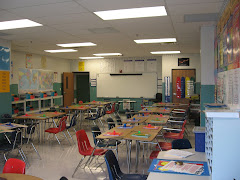We just started a new unit in Science on Weather. Here are teh GLCE's:
V.3.M.S. All Students will investigate and describe what makes up weather and how it changes from day to day, from season to season and over long periods of time
1.Explain pattern of changing weather and how they are measured
Key concepts: weather patterns-cold front, warm front, stationary front, air mass, and humidity.
Tools: Thermometer, rain gauge, wind direction indicator, anemometer, weather maps, satellite weather images
Real-world contexts: sudden temperature and cloud formation changes, records charts, and graphs of weather changes over periods of days; lake effect snow.
All Students will explain what causes different kinds of weather
2. Describe the composition and characteristics of the atmosphere.
Key Concepts: Composition-air, molecules, gas, water vapor, dust particles, ozone. Characteristics=air pressure and temperature changes with altitude, humidity.
Real-world contexts: examples of characteristics of the atmosphere, including pressurized cabins in airplanes, demonstrations of air pressure; examples of air-borne particulates, such as smoke, dust, pollen, bacteria; effects of humidity, such as condensation, dew on surfaces, comfort level of humans.
3. Explain the behavior of water in the atmosphere.
Key Concepts: Water cycle-evaporation, water vapor, warm air rises, cooling condensation, clouds. Precipitation-rain, snow, hail, sleet, freezing rain. Relative humidity, dew point, for
Real-world contexts: aspects of the water cycle in weather, including clouds, fog, and precipitation, evaporation puddles, flooding droughts.
All Students will analyze the relationships between human activities and the atmosphere:
4. “Describe health effects of polluted air.
Key concepts: effects=breathing difficulties, irritated eyes. Sources- car exhaust, industrial emissions, acid rain.
Real-World Contexts: Locations and times where air quality is poor, local sources of potential air pollution; ozone warnings.
Subscribe to:
Post Comments (Atom)


No comments:
Post a Comment